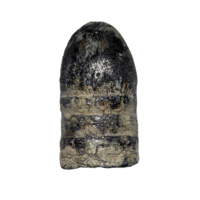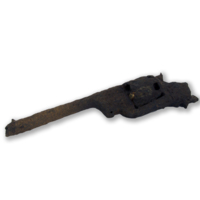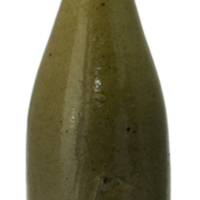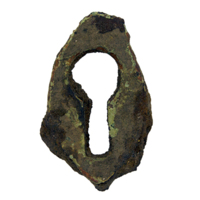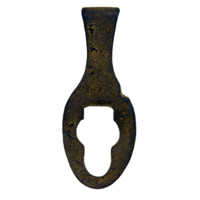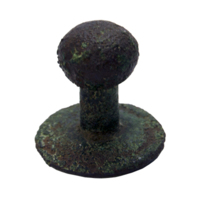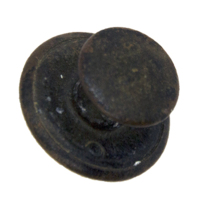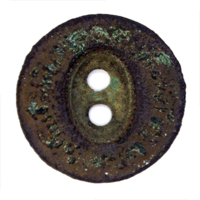Deaths at Old Smithfield in 1878
John McGillon (1846, Ireland–1878, Smithfield)
On Tuesday 5 February 1878 a party of three cedar-cutters, 32 year-old John McGillon, George W. Clarke and Robert Myers, visited Smithfield township to do some shopping and patronise the local hotels. About 10.30 p.m. they decided to return to their camp, which was up the river near the Barron Crossing. As they were rowing their small dinghy upstream McGillon fell overboard and before aid could be rendered, he had disappeared, “most probably carried down by the current”.1 Clarke and Myers called out to the missing man, but they were drunk and the night was very dark. They went up to the Barron crossing, woke the ferryman, Donald Cameron, and got him to bring a lantern and assist the search, but they were unable to find McGillon. The men assumed “an alligator had snapped at him” and pulled him out of the boat.
The following morning Clarke went to Smithfield and reported the incident.2 Shortly afterwards, McGillon’s fully-clothed body was found on a sand bar a little way downstream from the township. Constable James H. Norris brought the body to the wharf, where he found part of McGillon’s face had been eaten by fish and his left eye was missing.3
James Duncan J.P. held a Magisterial Inquiry, which found no evidence of foul play and Clarke and Myers were not deemed negligent.4 McGillon was buried at Smithfield on 11 February 1878, six days after he went missing.5
⇒ Read the Coroner's Inquest HERE
Ellen Koch (nee Tobin. 1836, Tipperary–1878, Smithfield)
The weather in April 1878 was wet, with rain falling almost every day, which made things unpleasant and unhealthy, and many people were struck down with fevers.6 Prior to the identification of contaminated water and mosquitoes as vectors of Tropical diseases, the wet weather was considered to be unhealthy because it was believed to produce miasma – poisonous vapours emanating from rank vegetation and rotting organic matter, which were thought to be particularly potent at night. Fevers were considered an occupational hazard for Europeans living in the Tropics. Now many people in Smithfield and Cairns were struck down.
On 2 April 1878, Smithfield storekeeper and publican Ellen Koch contracted ‘jungle fever’, and she died four days later.7 Ellen was buried the next day at the Cairns Cemetery on the Esplanade.8
Maria MacDonald (nee Ray. 1848-2 May 1878, Smithfield)
30 year-old Maria was the wife of Charles Hugh Macdonald, Inspector of Roads and Government Roads Overseer for the Northern District.9 Charles was constructing the dray road up the Lamb Range to the Hodgkinson goldfields. They had their first child, Percy Ray in Cooktown in February 1878,10 but shortly after returning home to Smithfield, Maria contracted a fever.11 She died of 'inflammation of the intestines' on 2 May 1878 and was buried at Smithfield the next day.12
William Emmett (1833–13 May 1878, Smithfield)
Forty-five year-old William Emmett, a sawyer, had been suffering from fever for six weeks. He died at [William Wade's Golden Age Hotel?] at West Smithfield on Sunday 13 May 1877 and was buried near Smithfield the next day.13
Christopher Kelly (1870, Queensland-18 May 1878, Smithfield)
Six year-old Christopher Kelly's parents, William and Bridget, were the proprietors of the North Star Hotel on Macdonald Street in Smithfield. On 18 May 1878 Christopher suffered 'convulsions' and died. He was buried at Smithfield the next day.14
Rebecca Crossland (1878-1878, Smithfield)
Edwin Crossland and his heavily pregnant wife Sarah were among the first Anglo-Australian residents to arrive at the new port of Cairns, and when their son, Albert Edwin,15 was born in November 187616 he was believed to be the first white child born at Trinity Inlet.17
The Crosslands moved to Smithfield, where Edwin worked as a blacksmith. Their next child, Rebecca, was born two years later on 5 November 1878 at Smithfield.18 Baby Rebecca only survived eleven days and died of ‘convulsions’ on 16 November 1878. She was buried at Smithfield the next day.19
The Crosslands were among the last people left at Smithfield in November 1878, with many of the businesses and stores having recently shifted up the coast to the new settlement at Island Point (later renamed Port Douglas). However, although Smithfield Township and West Smithfield were almost ghost towns, surveyor Frederick Horatio Warner had just finalised the survey of the new five-acre Smithfield Cemetery, and Rebecca’s interment was the ninth registered burial at the township.20
The new Cemetery Reserve was 900 metres west-south-west of the township, and presumably surveyor Warner set out the cemetery around the nine existing graves, but he did not mark anything on his survey plan or in his field-notes to indicate this was the case. Nevertheless, Rebecca’s interment would have been the first in the new Cemetery Reserve, her small grave being dug somewhere near the gum tree at the corner of the Reserve that Warner had marked with the carved letter ‘C’. The Cemetery was proclaimed and gazetted a month later on 17 December 1878.21
 |
This webpage is an excerpt from the upcoming book Old Smithfield: Barron River township (1876-1879) by Dr Dave Phoenix. Find Out More Here |
Featured Artefacts from Old Smithfield:
-
1. Morning Bulletin (Rockhampton), 14 February 1878: 2, reprinting an article from the Cairns Advertiser & Smithfield Observer. ↩
-
2. Hodgkinson Mining News, 23 February 1878: 2,
D2108, Cairns Historical Society. ↩ -
3. Inquest ID348656,
Queensland State Archives. ↩ -
4. Queensland death certificate 1878/C382. ↩
-
5. Smithfield Cemetery and stray burials file,
Cairns and District Family Historical Society. ↩ -
6. Telegraph (Brisbane), 20 May 1878: 2. ↩
-
7. Ellen Koch, nee Tobin (1836, Tipperary–1878, Smithfield), married
1: James Fahy/Fahey in South Australia in 1850, divorced in 1851,
then married 2: Henry Christopher Koch in 1854 in Sydney. ↩ -
8. Queensland death certificate 1878/C427. ↩
-
9. Charles Hugh Macdonald (1844, Campbelltown, NSW–1924, Brisbane), married Maria Ray (1848–1878, Smithfield) at Sydney in 1877,
NSW marriage certificate 1877/192. ↩ -
10. They had one child, Percy Ray (4 February 1878, Cooktown–1967),
Queensland birth certificate 1878/C717. ↩ -
11. After the death of his first wife, Maria, Charles married twice more:
2 - Honora ‘Nora’ Cormach (1859–1917) in Cooktown in 1881, and
3 - Rose Ethel Lane (1884–1964) in 1921 in Brisbane. ↩ -
12. Queensland death certificate 1878/C435. ↩
-
13. Queensland death certificate 1878/C443. ↩
-
14. Queensland birth certificate 1870/C2143,
Queensland death certificate 1878/C439. ↩ -
15. Albert Edwin Crossland (1876, Cairns–1932, Gordonvale),
Queensland death certificate 1932/C2383. ↩ -
16. In later life, Albert Edwin Crossland claimed to have been born on 20 September 1876, but his birth is also recorded as 4 November 1876, which seems a more probable date, as there were very few non-indigenous women at Trinity Bay in September 1876, see: Cairns Post, 30 July 1932: 4. ↩
-
17. The first birth registered in Cairns, according to the Cooktown Court House Records, was John Berszinsky, born 27 December 1876 (Queensland birth certificate 1877/C687). ↩
-
18. Queensland birth certificate 1878/C783. ↩
-
19. Queensland death certificate 1878/C480. ↩
-
20. Frederick Warner, Survey of Cemetery, Parish of Smithfield (12 March 1878), C8.88, Department of Natural Resources, Mines and Energy, Queensland Government. ↩
-
21. Queensland Government Gazette, 23 (1878), 1287, 21 December 1878. ↩


